Physical Address
304 North Cardinal St.
Dorchester Center, MA 02124
Eczema (eczematous inflammation) is the most common inflammatory skin disease. Although the term dermatitis is often used to refer to an eczematous eruption, the word means inflammation of the skin and is not synonymous with eczematous processes. Recognizing a rash as eczematous rather than psoriasiform or lichenoid, for example, is of fundamental importance if the clinician is to effectively diagnose skin disease. Here, as with other skin diseases, it is important to look carefully at the rash and to determine the primary lesion.
It is essential to recognize the quality and characteristics of the components of eczematous inflammation (erythema, scale, and vesicles) and to determine how these differ from other rashes with similar features. Once familiar with these features, the experienced clinician can recognize a process as eczematous even in the presence of secondary changes produced by scratching, infection, or irritation. With the diagnosis of eczematous inflammation established, a major part of the diagnostic puzzle has been solved.
There are three stages of eczema: acute, subacute, and chronic . Each represents a stage in the evolution of a dynamic inflammatory process ( Table 3.1 ). Clinically, an eczematous disease may start at any stage and evolve into another. Most eczematous diseases, if left alone (i.e., not irritated, scratched, or medicated), resolve in time without complication. This ideal situation is almost never realized; scratching, irritation, or attempts at topical treatment are almost inevitable. Some degree of itching is a cardinal feature of eczematous inflammation.
| Stage | Primary and Secondary Lesions | Symptoms | Etiology and Clinical Presentation | Treatment |
|---|---|---|---|---|
| Acute | Vesicles, blisters, intense redness | Intense itch | Contact allergy (poison ivy), severe irritation, id reaction, acute nummular eczema, stasis dermatitis, pompholyx (dyshidrosis), fungal infections | Cold, wet compresses; oral or intramuscular steroids; topical steroids; antihistamines; antibiotics |
| Subacute | Redness, scaling, fissuring, parched appearance, scalded appearance | Slight to moderate itch, pain, stinging, burning | Contact allergy, irritation, atopic dermatitis, stasis dermatitis, nummular eczema, asteatotic eczema, fingertip eczema, fungal infections | Topical steroids with or without occlusion, lubrication, antihistamines, antibiotics, tar |
| Chronic | Thickened skin, skin lines accentuated (lichenified skin), excoriations, fissuring | Moderate to intense itch | Atopic dermatitis, habitual scratching, lichen simplex chronicus, chapped fissured feet, nummular eczema, asteatotic eczema, fingertip eczema, hyperkeratotic eczema | Topical steroids (with occlusion for best results), intralesional steroids, antihistamines, antibiotics, lubrication |
Inflammation is caused by contact with specific allergens such as Rhus (poison ivy, oak, or sumac) and chemicals. In the id reaction, vesicular reactions occur at a distant site during or after a fungal infection, stasis dermatitis, or other acute inflammatory processes.
The degree of inflammation varies from moderate to intense. A bright red, swollen plaque with a pebbly surface evolves in hours. Close examination of the surface reveals tiny, clear, serum-filled vesicles ( Figs. 3.1 to 3.3 ). The eruption may not progress or it may evolve to develop blisters. The vesicles and blisters may be confluent and are often linear. Linear lesions result from dragging the offending agent across the skin with the finger during scratching. The degree of inflammation in cases caused by allergy is directly proportional to the quantity of antigen deposited on the skin. Excoriation predisposes to infection and causes serum, crust, and purulent material to accumulate.
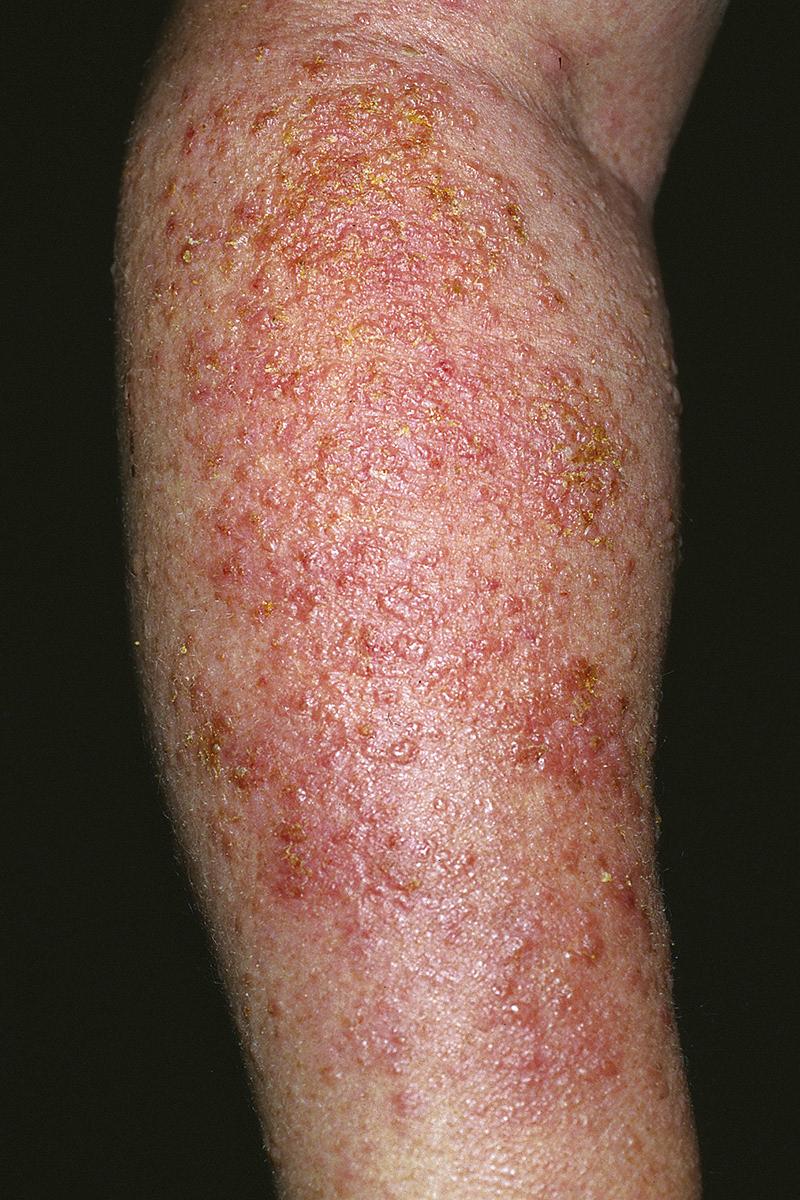
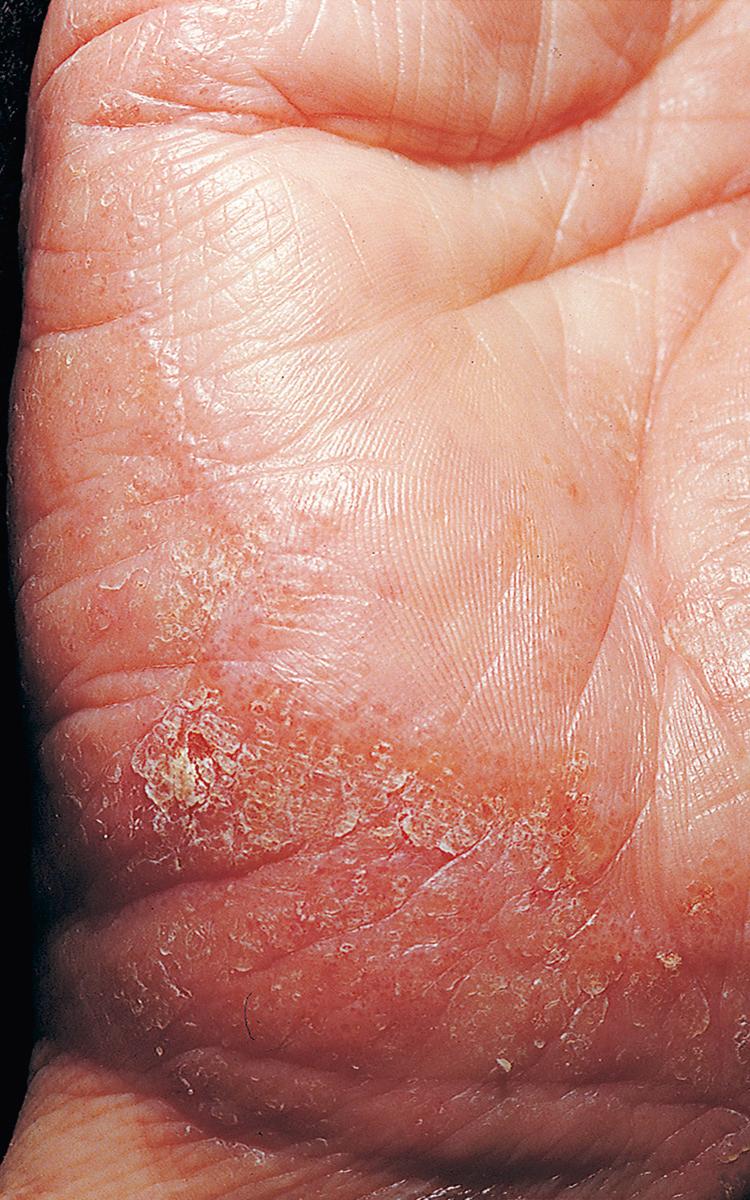
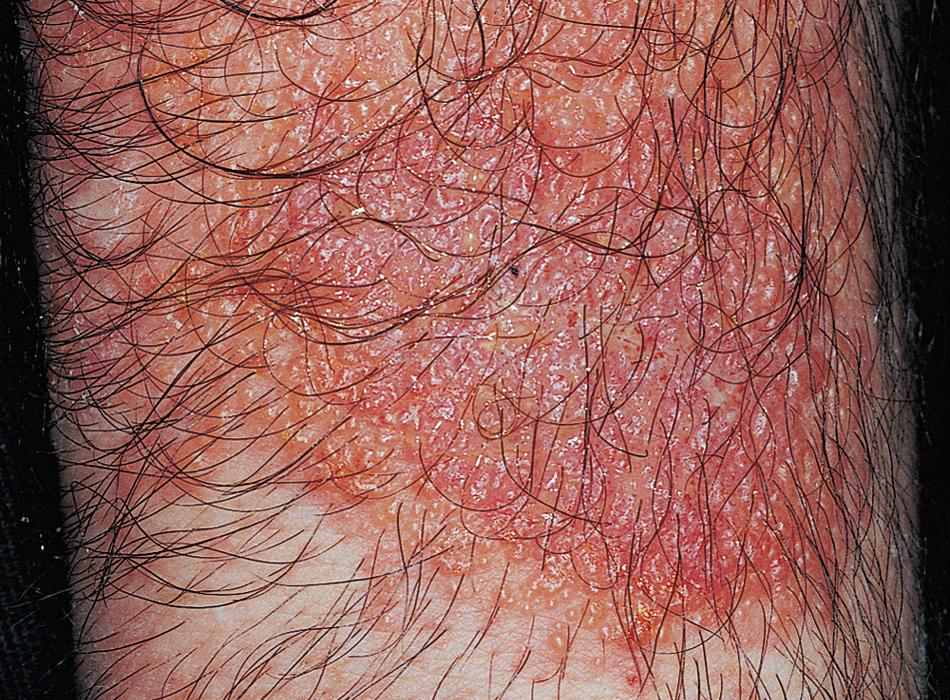
Acute eczema itches intensely. Patients scratch the eruption even while sleeping. A hot shower temporarily relieves itching because the pain produced by hot water is better tolerated than the sensation of itching; however, heat aggravates acute eczema.
Lesions may begin to appear from hours to 2 to 3 days after exposure and may continue to appear for 1 week or more. These later occurring, less inflammatory lesions are confusing to the patient, who cannot recall additional exposure. Lesions produced by small amounts of allergen are slower to evolve. They are not produced, as is generally believed, by contact with the serum of ruptured blisters, because the blister fluid does not contain the offending chemical. Acute eczematous inflammation evolves into a subacute stage before resolving.
The evaporative cooling produced by wet compresses causes vasoconstriction and rapidly suppresses inflammation and itching. Burow's powder may be added to water to create an antibacterial solution, but water alone is usually sufficient. A clean cotton cloth is soaked in cool water, folded several times, and placed directly over the affected areas. Evaporative cooling produces vasoconstriction and decreases serum production. Wet compresses should not be held in place and covered with towels or plastic wrap because this prevents evaporation. The wet cloth macerates vesicles and, when removed, mechanically debrides the area and prevents serum and crust from accumulating. Wet compresses should be removed after 30 minutes and replaced with a freshly soaked cloth. It is tempting to leave the drying compress in place and to wet it again by pouring solution onto the cloth. Although evaporative cooling will continue, irritation may occur from the accumulation of scale, crust, and serum and from the increased concentration of aluminum sulfate and calcium acetate, the active ingredients in Burow's powder.
Oral corticosteroids such as prednisone are useful for controlling intense or widespread inflammation and may be used in addition to wet dressings. Prednisone controls most cases of poison ivy when it is taken in 20-mg doses twice a day for 7 to 14 days (for adults); however, to treat intense or generalized inflammation, prednisone may be started at 30 mg or more twice a day and maintained at that level for 3 to 5 days. Sometimes 21 days of treatment are required for adequate control. The dosage should not be tapered for these relatively short courses because lower dosages may not give the desired antiinflammatory effect. Inflammation may reappear as diffuse erythema and may even be more extensive if the dosage is too low or is tapered too rapidly. Commercially available steroid dose packs taper the dosage and provide treatment for too short a time and so should not be used. Topical corticosteroids are of little use in the acute stage because the cream does not penetrate through the vesicles.
Antihistamines, such as diphenhydramine and hydroxyzine, do not alter the course of the disease, but they relieve itching and provide enough sedation so patients can sleep. They are given every 4 hours as needed. Doxepin is a tricyclic antidepressant (TCA) with potent antihistamine activity and is very effective in controlling itch.
The use of oral antibiotics may greatly hasten resolution of the disease if signs of superficial secondary infection, such as pustules, purulent material, and crusts, are present. Secondary infection is usually caused by Staphylococcus aureus and Streptococcus pyogenes . Deep infection (cellulitis) is rare with acute eczema. Cephalexin and dicloxacillin are effective; topical antibiotics are much less effective. Methicillin-resistant Staphylococcus aureus (MRSA) should be treated with doxycycline, minocycline, or trimethoprim/sulfamethoxazole.
Erythema and scale are present in various patterns, usually with indistinct borders ( Figs. 3.4 and 3.5 ). The redness may be faint or intense ( Figs. 3.6 to 3.9 ). Psoriasis, superficial fungal infections, and eczematous inflammation may have a similar appearance ( Figs. 3.10 to 3.13 ). The borders of the plaques of psoriasis and superficial fungal infections are well-defined. Psoriatic plaques have a deep, rich red color and silvery white scales.
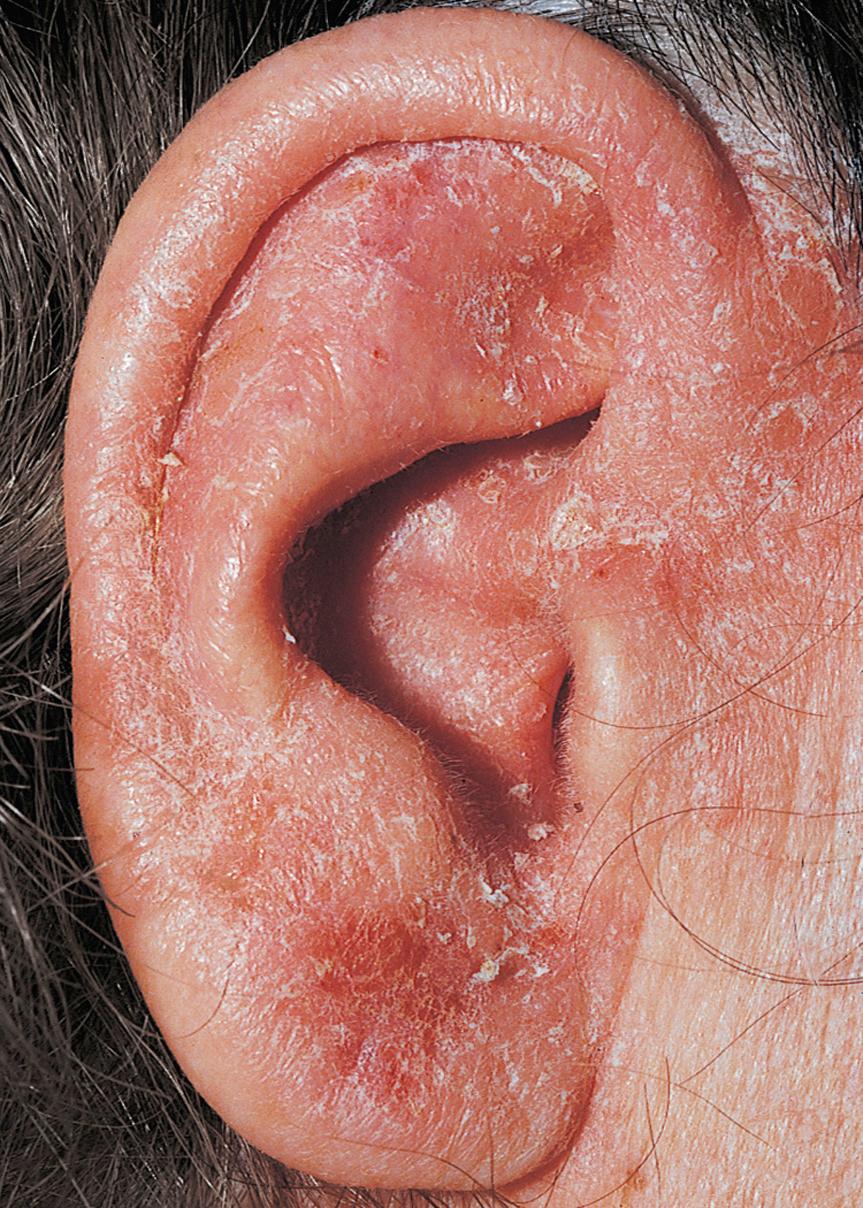
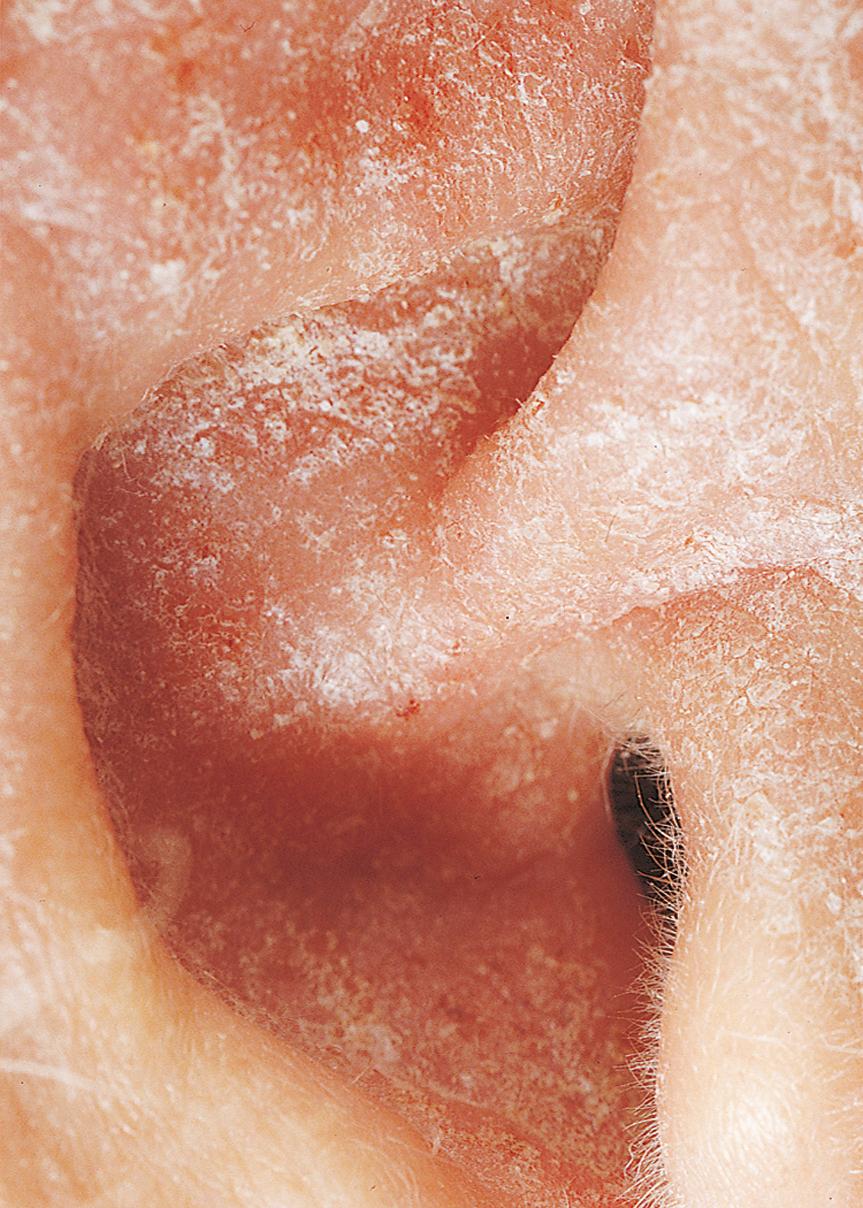
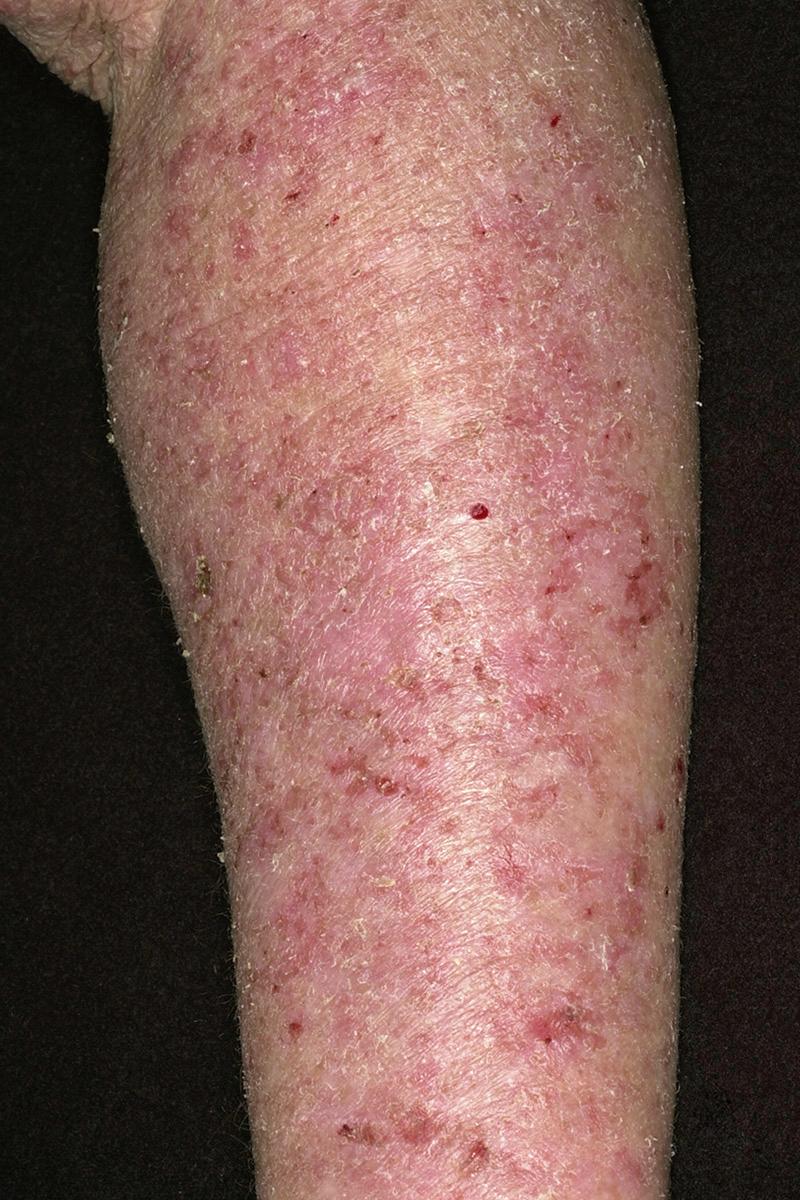
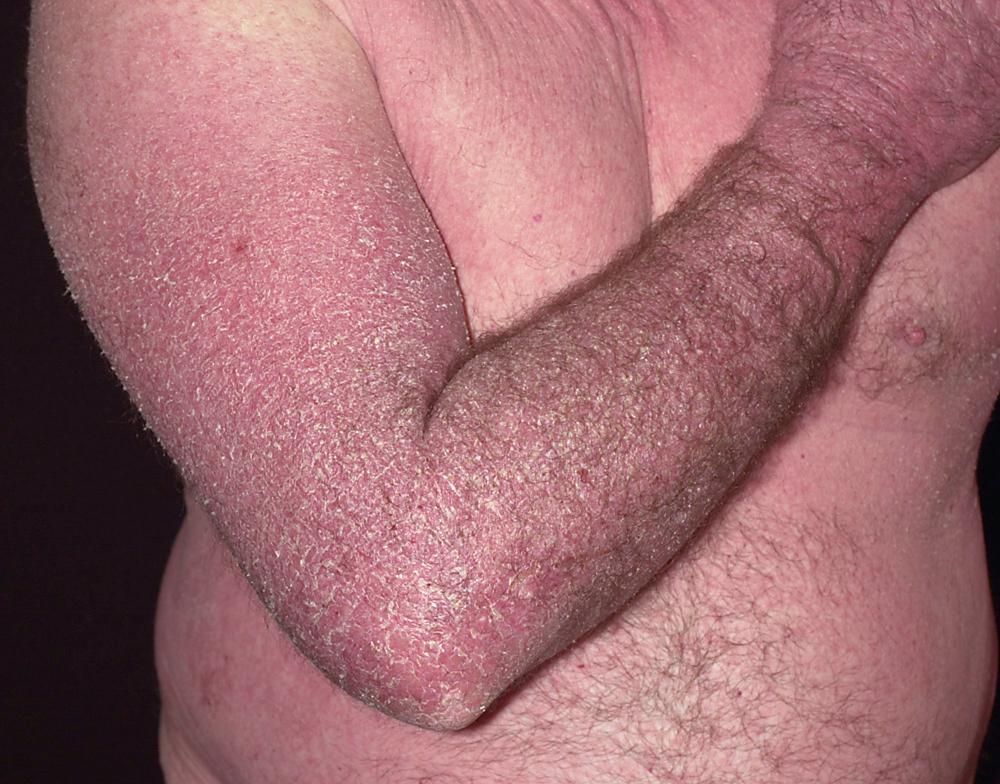
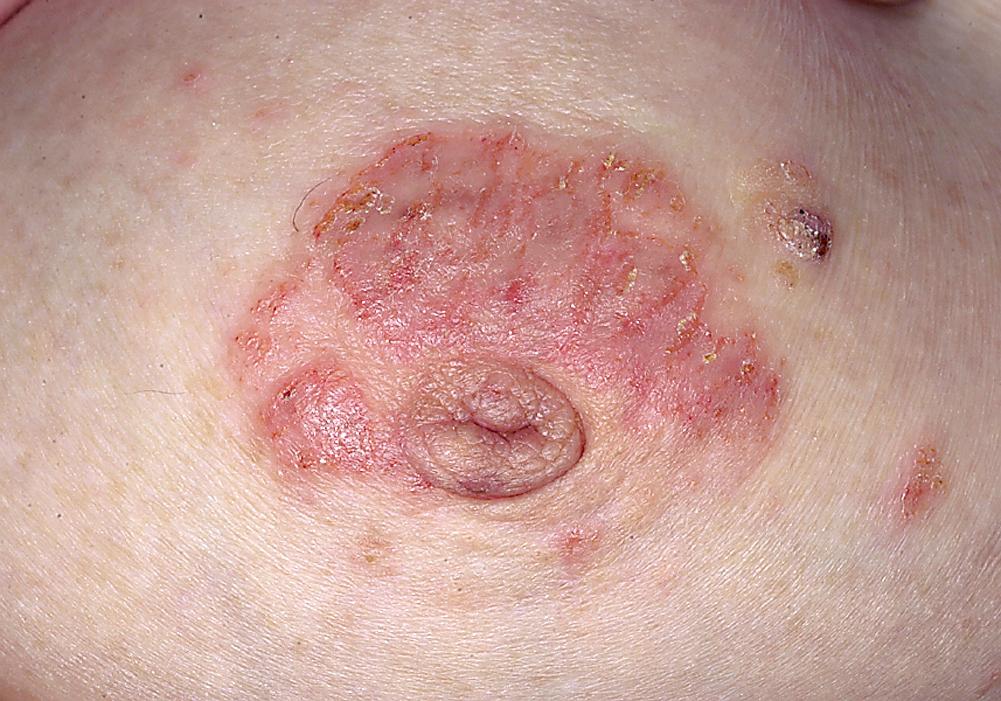
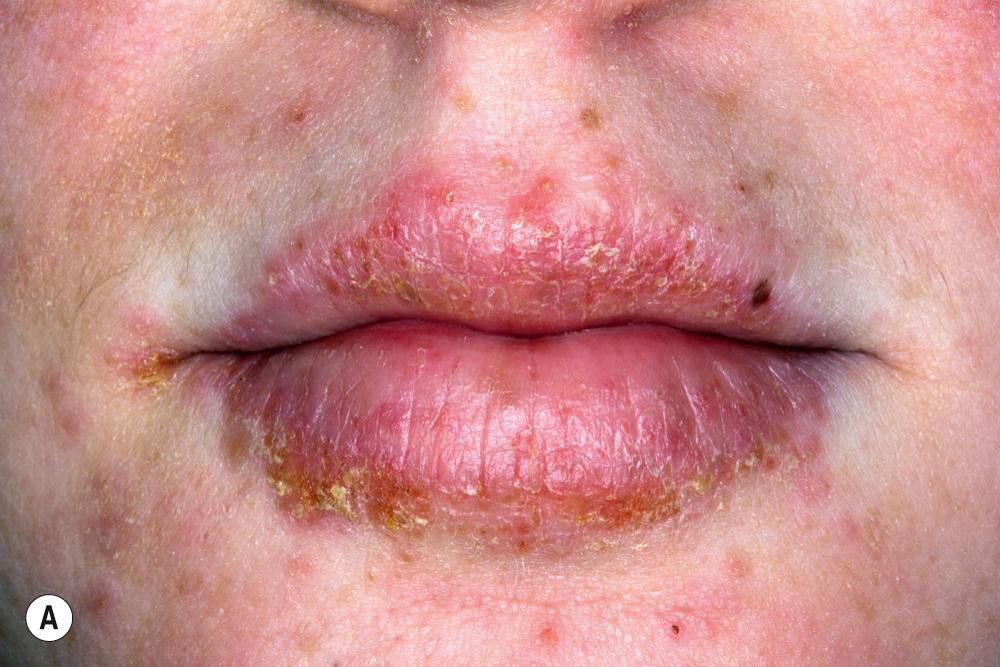
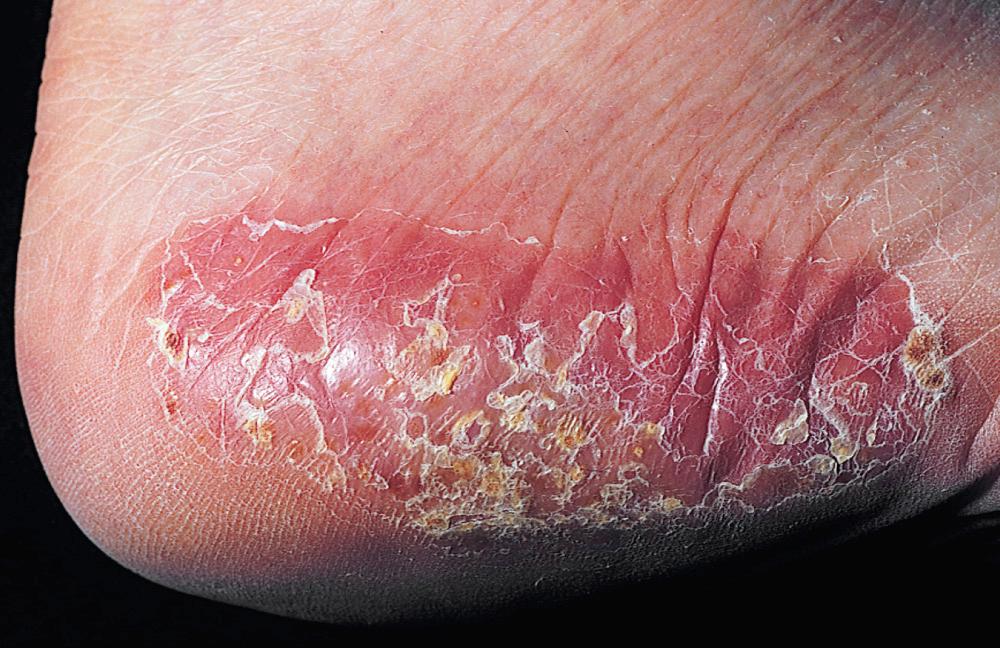
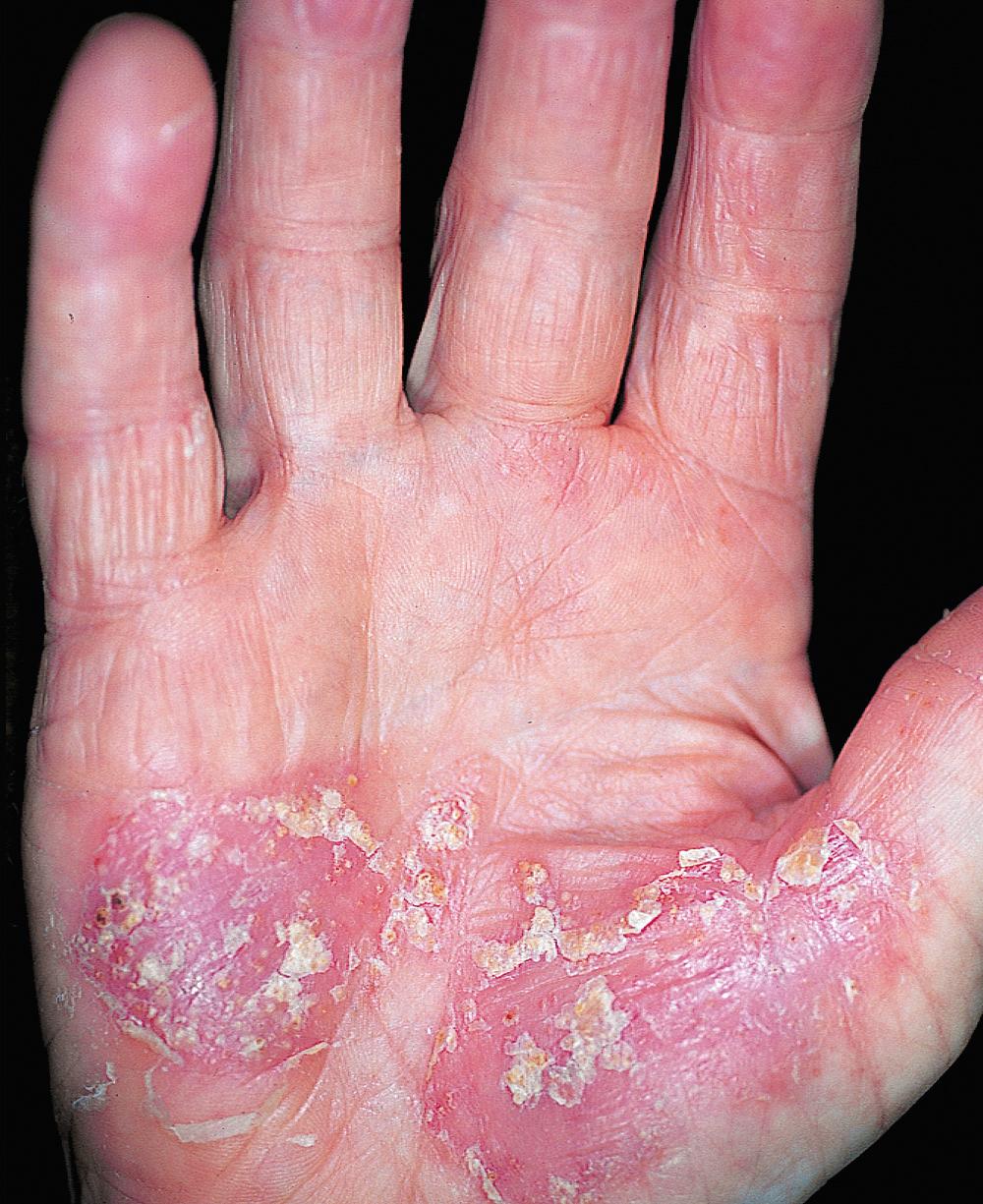
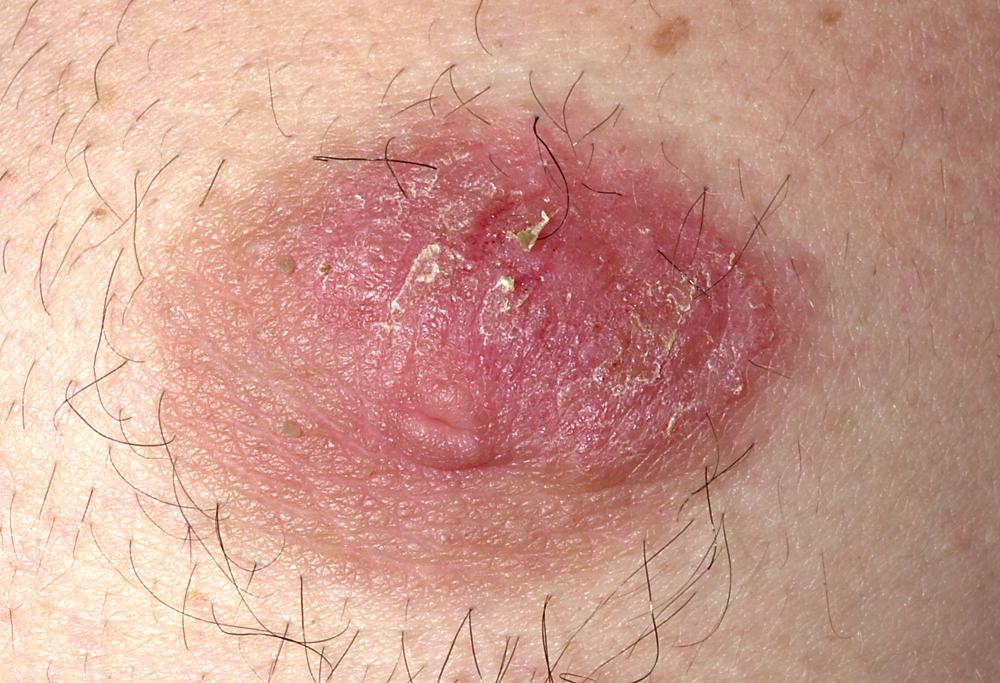
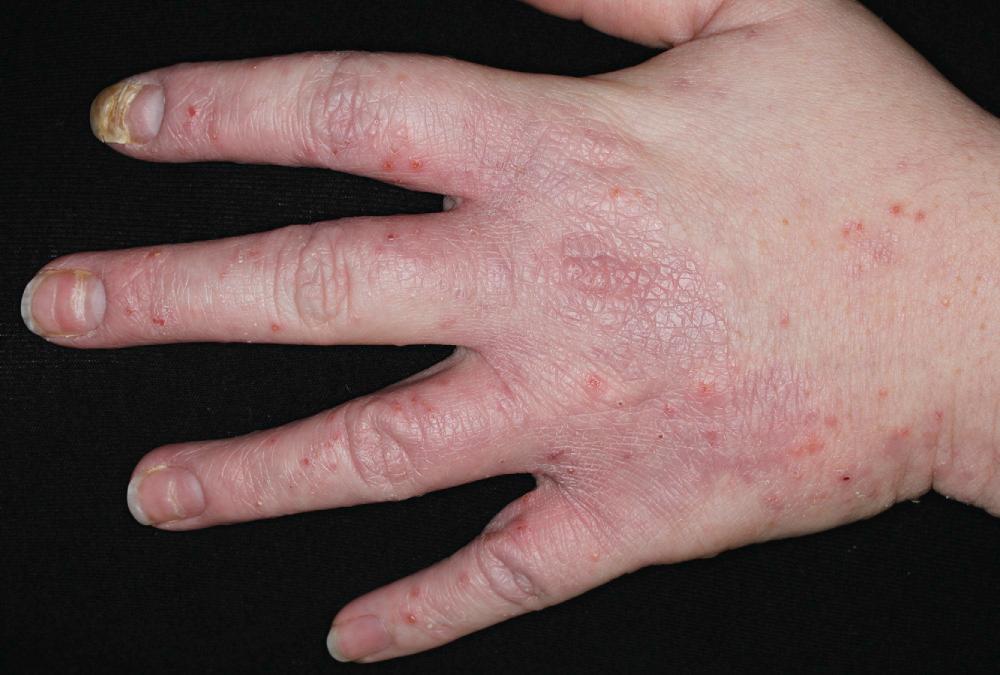
These vary from no itching to intense itching.
Subacute eczematous inflammation may be the initial stage or it may follow acute inflammation. Irritation, allergy, or infection can convert a subacute process into an acute process. Subacute inflammation resolves spontaneously without scarring if all sources of irritation and allergy are withdrawn. Excess drying created from washing or continued use of wet dressings causes cracking and fissures. If excoriation is not controlled, the subacute process can be converted to a chronic process. Diseases that have subacute eczematous inflammation as a characteristic are listed in Box 3.1 .
Allergic contact dermatitis
Asteatotic eczema
Atopic dermatitis
Chapped fissured feet (sweaty sock dermatitis)
Circumostomy eczema
Diaper dermatitis
Exposure to chemicals
Intertrigo
Irritant contact dermatitis
Irritant hand eczema
Nipple eczema (nursing mothers)
Nummular eczema
Perioral lick eczema
Stasis dermatitis
It is important to discontinue wet dressings when acute inflammation evolves into subacute inflammation. Excess drying creates cracking and fissures, which predispose to infection.
These agents are the treatment of choice (see Chapter 2 ). Creams may be applied two to four times a day or with occlusion. Ointments may be applied two to four times a day for drier lesions. Subacute inflammation requires group III through V corticosteroids for rapid control. Occlusion with creams hastens resolution and is less expensive. Weaker products such as triamcinolone cream 0.1% give excellent results. Staphylococcus aureus colonizes eczematous lesions, but studies show their numbers are significantly reduced following treatment with topical steroids.
Tacrolimus ointment and pimecrolimus cream are the first topical macrolide immune suppressants that are not hydrocortisone derivatives. They inhibit the production of inflammatory cytokines in T cells and mast cells and prevent the release of preformed inflammatory mediators from mast cells. Dermal atrophy does not occur. These agents are effective for the treatment of inflammatory skin diseases, such as atopic dermatitis, allergic contact dermatitis, and irritant contact dermatitis. They are approved for use in children aged 2 years or older. Response to these agents is slower than the response to topical steroids. To obtain rapid control, topical steroids may be used for several days before the use of these agents.
Pimecrolimus permeates through skin at a lower rate than tacrolimus, indicating a lower potential for percutaneous absorption. The cream is applied twice a day and may be used on the face. Continuous long-term use of topical calcineurin inhibitors in any age group should be avoided, and application should be limited to areas of dermatitis involvement.
Tacrolimus is effective in the treatment of children (aged 2 years and older) and adults with atopic dermatitis and eczema. The most prominent adverse event is application site burning and erythema. Tacrolimus is available in 0.03% and 0.1% ointment formulations. Some clinicians find the 0.03% concentration to be marginally effective. Continuous long-term use of topical calcineurin inhibitors in any age group should be avoided, and application should be limited to areas of dermatitis involvement.
Topical crisaborole ointment is indicated for mild to moderate atopic dermatitis in patients 2 years of age and older. Crisaborole is a phosphodiesterase 4 (PDE-4) inhibitor. Although the precise mechanism by which crisaborole improves eczema is unknown, inhibition of phosphodiesterase increases intracellular levels of cyclic adenosine monophosphate (cAMP). Increased intracellular levels of cAMP inhibit NF-κB, resulting in a decrease in tumor necrosis factor alpha and other proinflammatory cytokines. These effects are prominent in tissues that utilize PDE-4 such as leukocytes (mast cells, eosinophils, neutrophils, monocytes, and macrophages), dermis, smooth muscle, and vascular endothelium. Crisaborole is applied in a thin layer twice to the affected areas. The most common side effect is pain at the site of application.
A topical form of the antidepressant doxepin is effective for the relief of pruritus associated with eczema in adults and children more than 12 years old. The two most common adverse effects are stinging at the site of application and drowsiness. The medication can be applied four times a day as needed.
This is a simple but essential part of therapy. Inflamed skin becomes dry and is more susceptible to further irritation and inflammation. Resolved dry areas may easily relapse into subacute eczema if proper lubrication is neglected. Lubricants are best applied a few hours after topical steroids and should be continued for days or weeks after the inflammation has cleared. Frequent application (one to four times a day) should be encouraged. Applying lubricants directly after the skin has been patted dry following a shower seals in moisture. Lotions or creams with or without the hydrating chemicals urea and lactic acid may be used. Bath oils are very useful if used in amounts sufficient to make the skin feel oily when the patient leaves the tub.
Curél, DML, Lubriderm, Cetaphil, Aveeno, Eucerin, and many other products are useful.
DML, Aveeno, Neutrogena, Nivea, Eucerin, Acid Mantle, and many other products are useful.
Frequent washing with a drying soap, such as Ivory, delays healing. Infrequent washing with mild or superfatted soaps (e.g., Dove Sensitive Skin, Cetaphil, Basis) should be encouraged.
Eczematous plaques that remain bright red during treatment with topical steroids may be infected ( Fig. 3.14 ). Infected subacute eczema should be treated with appropriate systemic antibiotics, which are usually those active against Staphylococci. Systemic antibiotics are more effective than topical antibiotics or antibiotic–steroid combination creams.
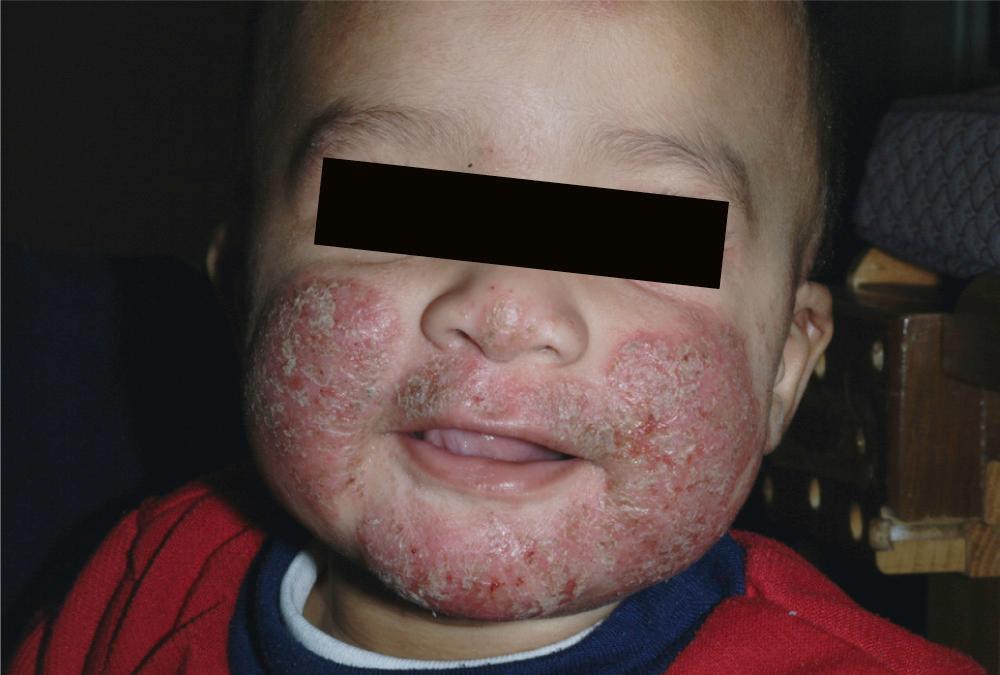
Tar ointments, baths, and soaps were among the few effective therapeutic agents available for the treatment of eczema before the introduction of topical steroids. Topical steroids provide rapid and lasting control of eczema in most cases. Some forms of eczema, such as atopic dermatitis and irritant eczema, tend to recur. Topical steroids become less effective with long-term use. Tar is sometimes an effective alternative in this setting. Tar ointments or creams may be used for long-term control or between short courses of topical steroids.
Generalized eczema or erythroderma may be the presenting sign of cutaneous T-cell lymphoma. Intractable pruritus has been associated with Hodgkin lymphoma. Unexplained eczema of adult onset may be associated with an underlying lymphoproliferative malignancy. Patients may have widespread erythematous plaques that are poorly responsive to therapy. When a readily identifiable cause (e.g., contactants, drugs, or atopy) is not found, a systematic evaluation should be pursued.
Chronic eczematous inflammation may be caused by irritation of subacute inflammation, or it may appear as lichen simplex chronicus.
Chronic eczematous inflammation is a clinical–pathologic entity and does not indicate simply any long-lasting stage of eczema. If scratching is not controlled, subacute eczematous inflammation can be modified and converted to chronic eczematous inflammation ( Figs. 3.15 to 3.17 ). The inflamed area thickens, and surface skin markings may become more prominent. Thick plaques with deep parallel skin markings (“washboard” lesions) are said to be lichenified ( Fig. 3.18 ). The border is well-defined but not as sharply defined as it is in psoriasis ( Fig. 3.19 ) ![]() . The sites most commonly involved are those areas that are easily reached and associated with habitual scratching (e.g., dorsal feet, lateral forearms, anus, and occipital scalp), areas where eczema tends to be long-lasting (e.g., the lower legs, as in stasis dermatitis), and the crease areas (antecubital and popliteal fossae, wrists, behind the ears, and ankles) in atopic dermatitis ( Figs. 3.20 to 3.24 ).
. The sites most commonly involved are those areas that are easily reached and associated with habitual scratching (e.g., dorsal feet, lateral forearms, anus, and occipital scalp), areas where eczema tends to be long-lasting (e.g., the lower legs, as in stasis dermatitis), and the crease areas (antecubital and popliteal fossae, wrists, behind the ears, and ankles) in atopic dermatitis ( Figs. 3.20 to 3.24 ).
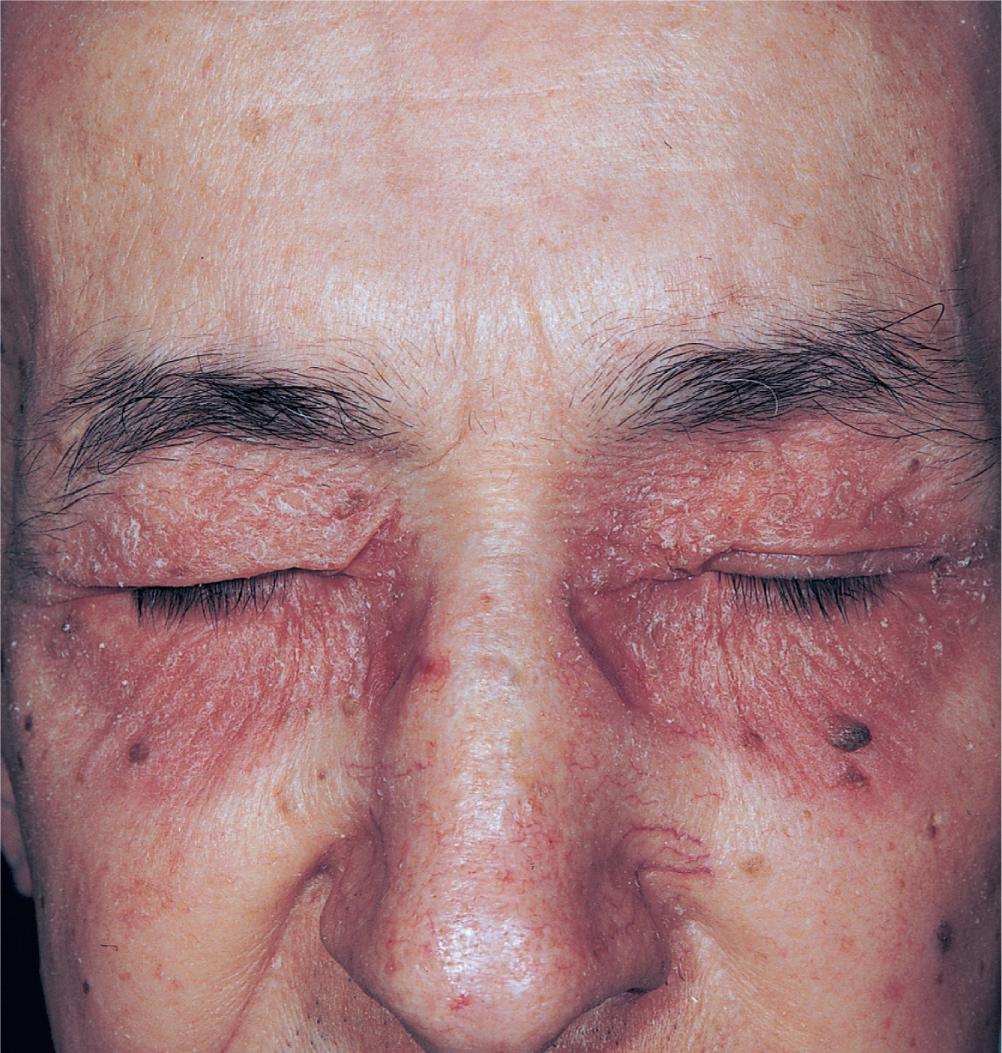
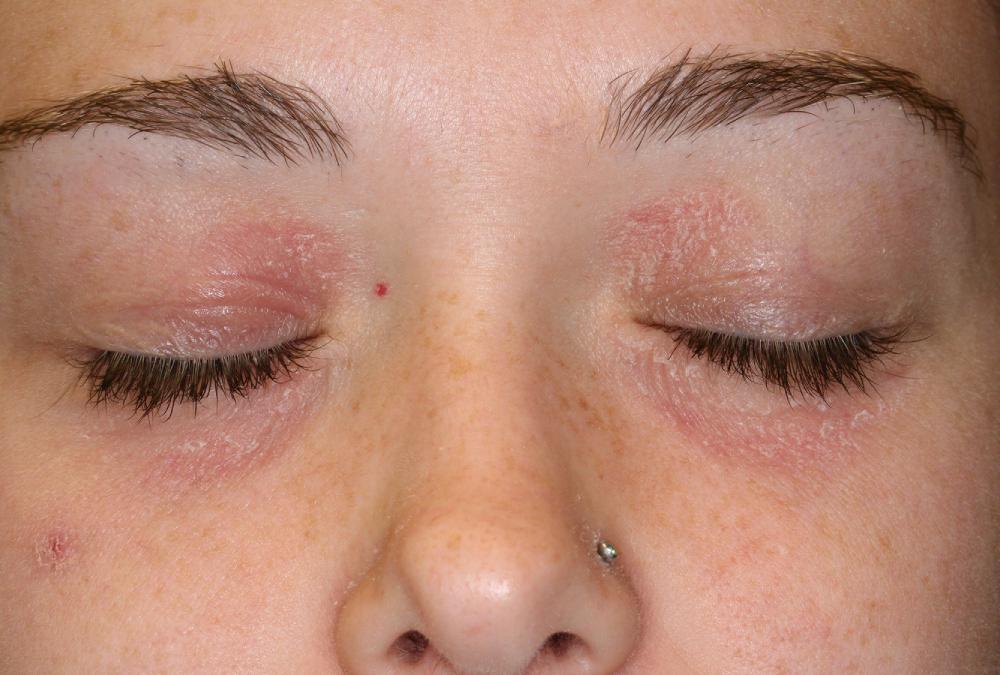
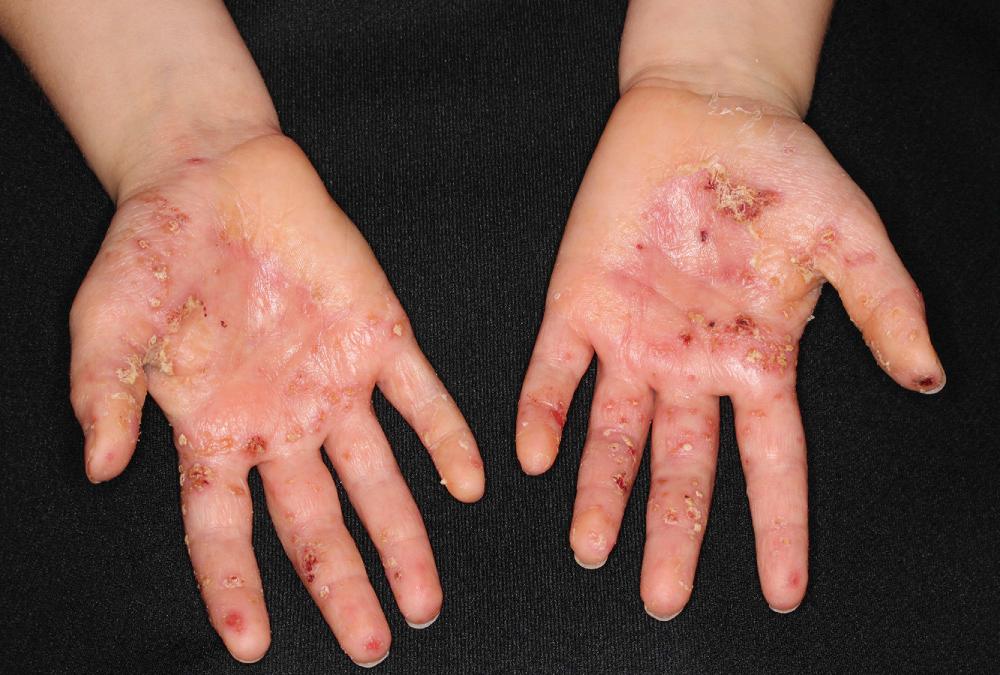
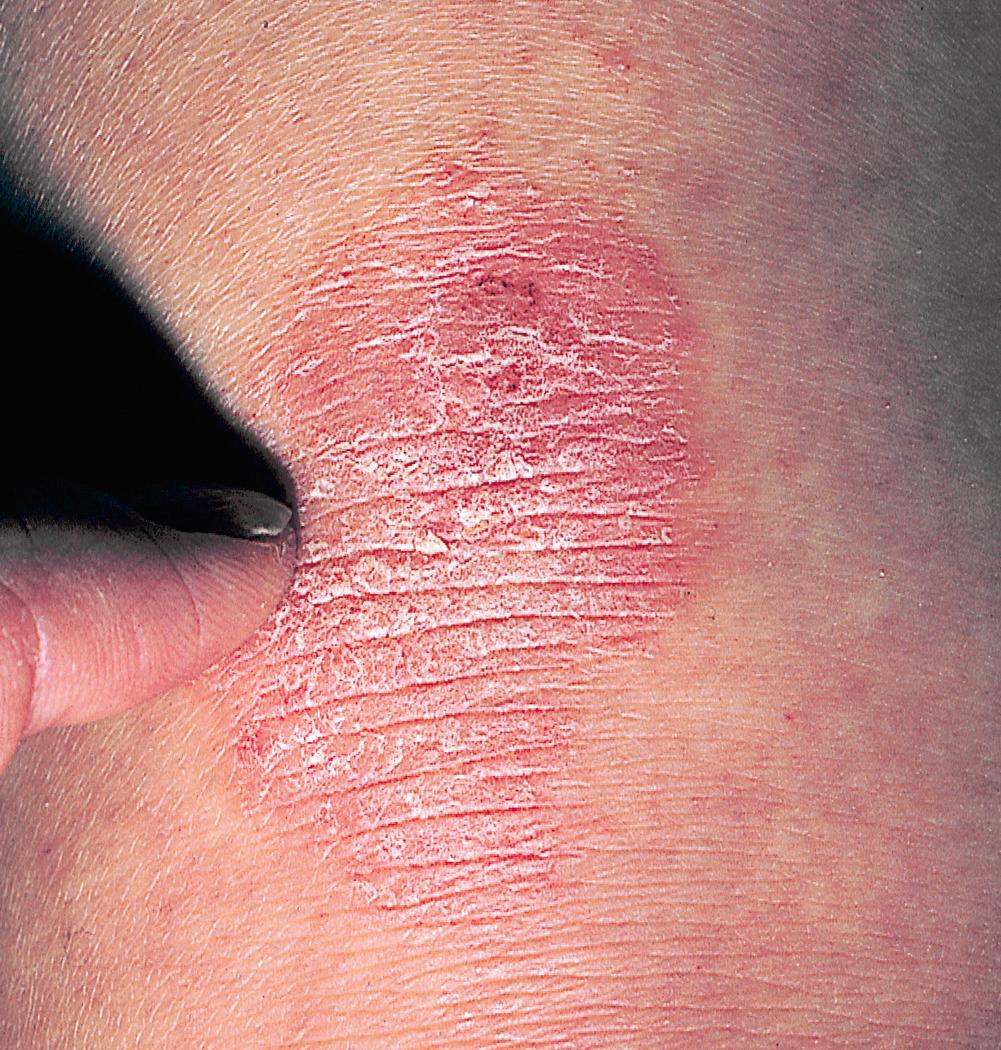
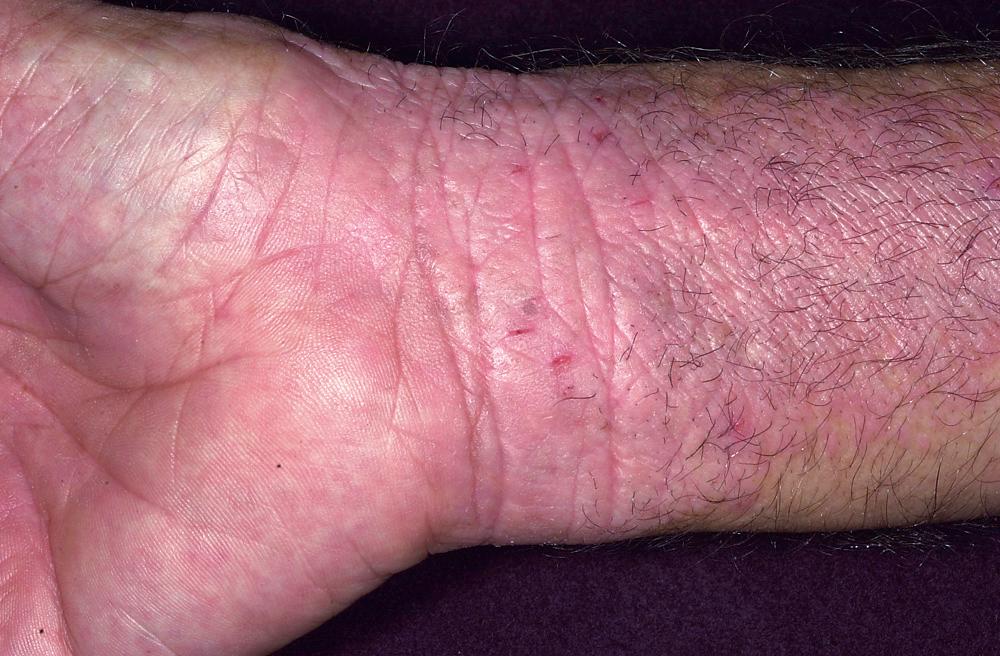
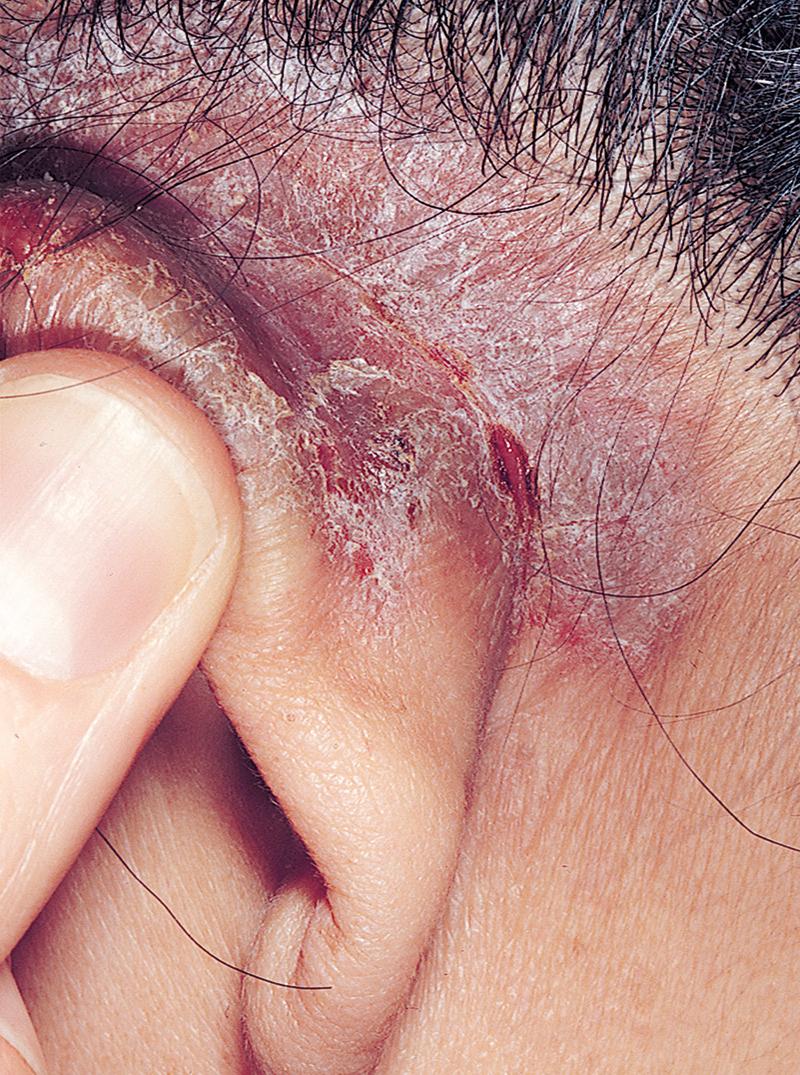
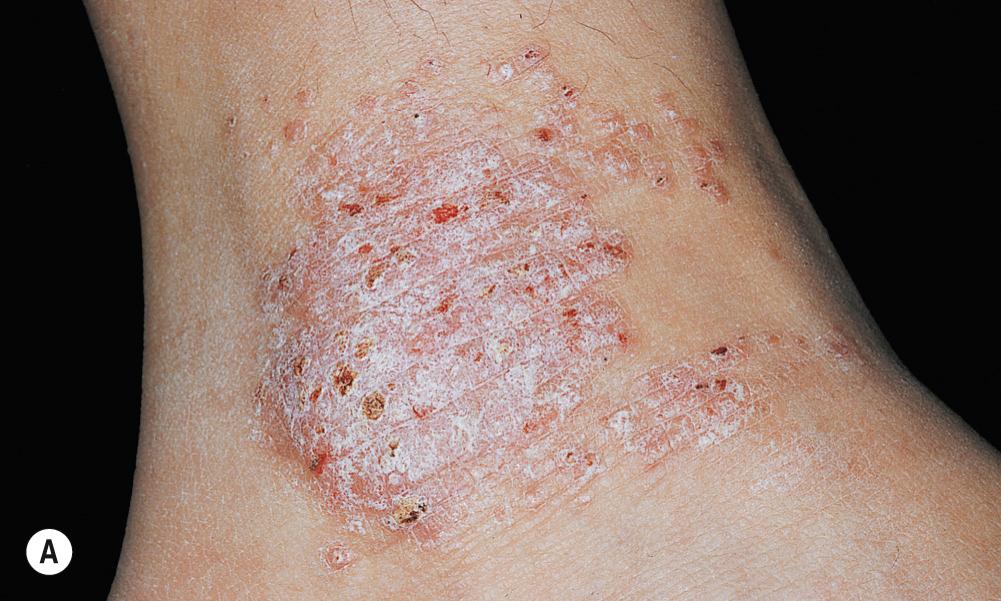
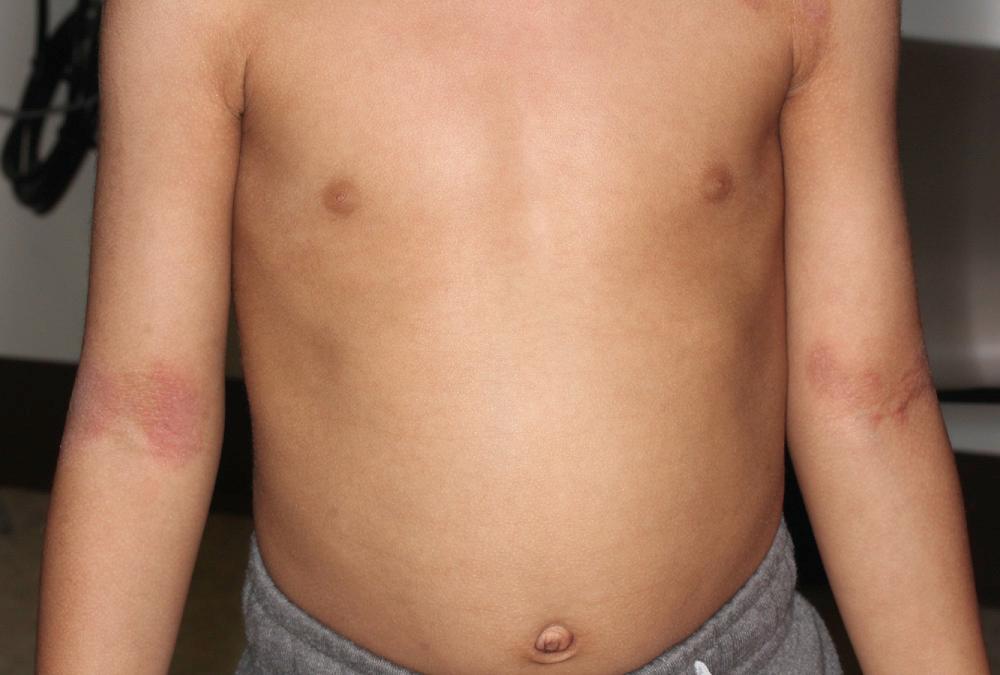
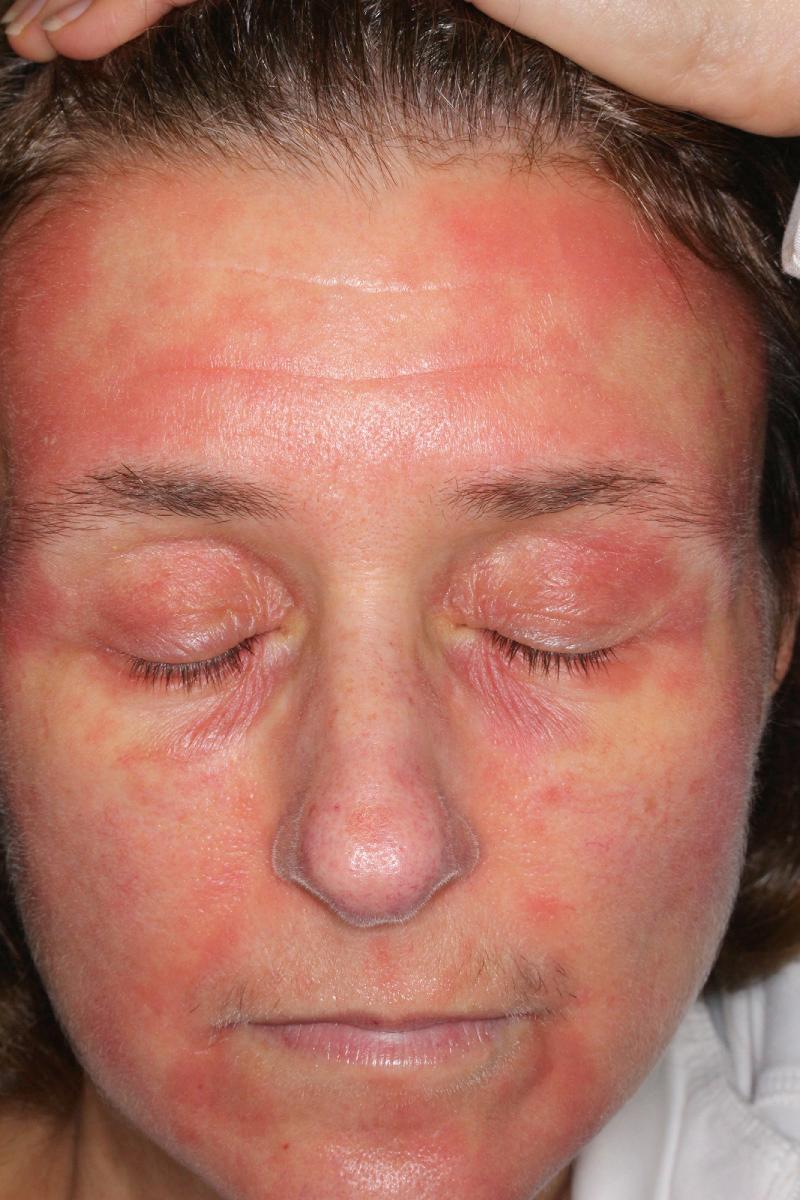
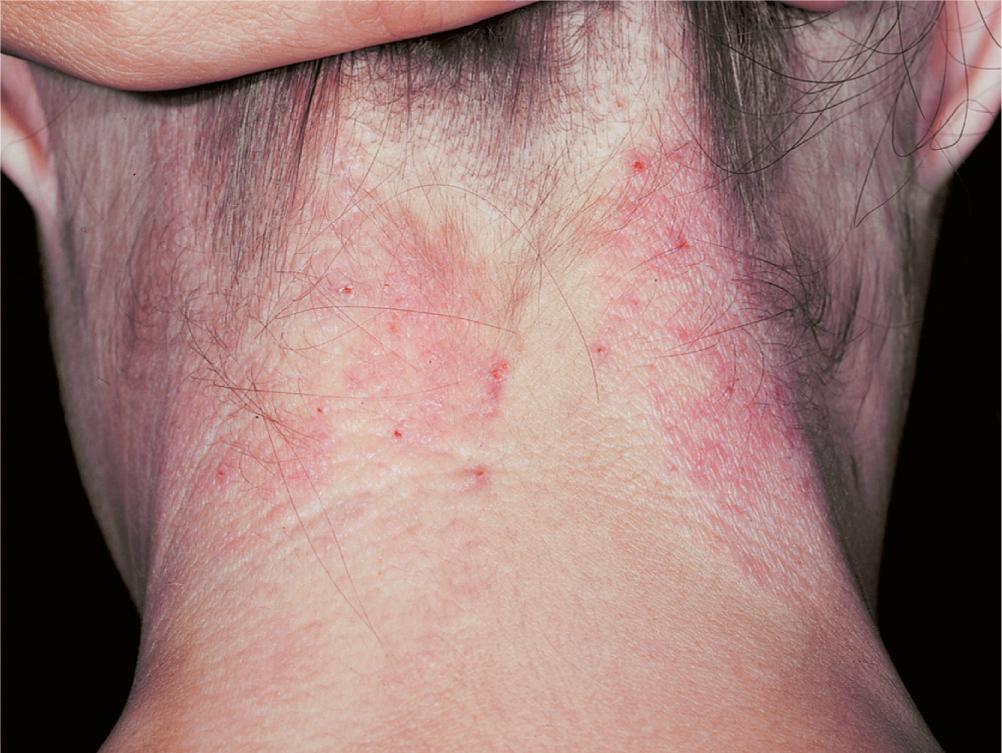
There is moderate to intense itching. Scratching sometimes becomes violent, leading to excoriation and digging, and ceases only when pain has replaced the itch. Patients with chronic inflammation scratch while asleep.
Scratching and rubbing become habitual and are often done subconsciously. The disease then becomes self-perpetuating. Scratching leads to thickening of the skin, which results in even more intense pruritus. It is this habitual manipulation that causes the difficulty in eradicating this disease. Some patients enjoy the feeling of relief that comes from scratching and may actually desire the reappearance of their disease after treatment.
Chronic eczematous inflammation is resistant to treatment and requires potent steroid therapy.
Group II through V topical steroids are used with occlusion each night until the inflammation clears – usually in 1 to 3 weeks; group I topical steroids are used without occlusion. Tacrolimus ointment 0.1% can be used as a primary treatment or used alternately with topical steroids.
Intralesional injection (triamcinolone acetonide 10 mg/mL) is a very effective mode of therapy. Lesions that have been present for years may completely resolve after one injection or a short series of injections. The medicine is delivered with a 27- or 30-gauge needle, and the entire plaque is infiltrated until it blanches white. Resistant plaques require additional injections given at 3- to 4-week intervals.
Inflammation of the hands is one of the most common problems encountered by the dermatologist. Hand dermatitis causes discomfort and embarrassment and, because of its location, interferes significantly with normal daily activities. Hand dermatitis is common in industrial occupations: it can threaten job security if inflammation cannot be controlled. Box 3.2 lists instructions for patients with irritant hand dermatitis.
Wash hands as infrequently as possible. Ideally, soap should be avoided and hands simply washed in lukewarm water.
Shampooing must be done with rubber gloves or by someone else.
Avoid direct contact with household cleaners and detergents. Wear cotton, plastic, or rubber gloves when doing housework.
Do not touch or do anything that causes burning or itching (e.g., wool; wet diapers; peeling potatoes or handling fresh fruits, vegetables, and raw meat).
Wear rubber gloves when irritants are encountered. Rubber gloves alone are not sufficient because the lining collects sweat, scales, and debris and can become more irritating than those objects to be avoided. Dermal white cotton gloves should be worn next to the skin under unlined rubber gloves. Several pairs of cotton gloves should be purchased so they can be changed frequently. Ensure the rubber gloves fit comfortably over the white cotton gloves.
A large study provided the following statistics: the prevalence of hand eczema was approximately 5.4% and was twice as common in females as in males. The most common type of hand eczema was irritant contact dermatitis (35%), followed by atopic hand eczema (22%) and allergic contact dermatitis (19%). The most common contact allergies were to nickel, cobalt, fragrance mix, balsam of Peru, and colophony. Of all the occupations studied, cleaners had the highest prevalence at 21.3%. Hand eczema was more common among people reporting occupational exposure. The most harmful exposure was to chemicals, water and detergents, dust, and dry dirt. A change of occupation was reported by 8% and was most common in service workers. Hairdressers had the highest frequency of change. Hand eczema was shown to be a long-lasting disease with a relapsing course; 69% of the patients had consulted a physician, and 21% had been on sick leave at least once because of hand eczema. The mean total sick-leave time was 18.9 weeks; the median was 8 weeks. The most important predictive factors for hand eczema are listed in Box 3.3 .
History of childhood eczema (most important predictive factor)
Female gender
Occupational exposure
History of asthma and/or hay fever
Service occupation (e.g., professional cleaners)
The diagnosis and management of hand eczema are a challenge. There is almost no association between clinical pattern and etiology. No distribution of eczema is typically allergic, irritant, or endogenous. Not only are there many patterns of eczematous inflammation ( Tables 3.2 and 3.3 ), but also there are other diseases, such as psoriasis, that may appear eczematous. Many patients diagnosed with hand eczema actually have psoriasis. The original primary lesions and their distribution become modified with time by irritants, excoriation, infection, and treatment. All stages of eczematous inflammation may be encountered in hand eczema.
| Location | Redness and Scaling | Vesicles | Pustules |
|---|---|---|---|
| Back of hand |
|
|
|
| Palmar surface |
|
|
|
| Classification | Comments |
|---|---|
| ETIOLOGIC | |
| Irritant contact dermatitis | Repeated exposure to irritants (mild toxic agents) over a prolonged period may cause an inflammatory response of the skin, compromising the skin's barrier function and making it susceptible to the development of contact allergy. In most patients there is a history of exposure to “wet” work (contact with soaps or solvents) or prolonged use of occlusive gloves. There are no clinically useful tests to assess reactions to irritants; diagnosis is often based on the absence of contact allergy, which is determined with the use of patch testing. |
| Atopic hand dermatitis | Patients often have a history of asthma, hay fever, or “childhood eczema” (atopic dermatitis in childhood). Both prick testing with inhalation of food allergens and determination of serum IgE levels are of limited value and not routinely recommended. Because the barrier function of the skin is compromised, patients are predisposed to irritant contact dermatitis. |
| Allergic contact dermatitis | This condition generally reflects a delayed-type, T lymphocyte–mediated contact allergy to a chemical substance. Typical contact allergens include nickel (e.g., in tools or jewelry), chromate (e.g., in leather or cement), rubber additives (e.g., in gloves), and preservatives (e.g., in creams or cosmetics). Ingestion of a substantial amount of the allergen (e.g., nickel) may also provoke hand eczema, but its occurrence is rare. Diagnosis is supported by a history of exposure in combination with a positive reaction to patch testing with contact allergens. |
| Hybrid hand eczema | This type of eczema combines aspects of irritant contact dermatitis, atopic hand dermatitis, and allergic contact dermatitis. |
| Protein contact dermatitis | This subtype of allergic contact dermatitis frequently occurs in patients in professions involving food. Initially, the reaction to proteins is urticarial (contact urticaria), but eczema may develop. IgE reactions to specific proteins are often (but not always) detected with prick tests or serum analysis. Latex allergy is a related phenomenon. |
| Unclassified | In patients with chronic hand eczema, the original causative factor tends to become irrelevant. |
| MORPHOLOGIC (SEE P. 101 ) | |
| Recurrent vesicular, or dyshidrotic, hand eczema; pompholyx | The classic presentation is an eruption of large vesicles on the palms that tends to recur; it also includes recurrent vesicular eruptions on the palms and the palmar and lateral sides of the fingers, which is known as macrovesicular eczema (these patients often also have eruptions on the soles of the feet). The name dyshidrotic eczema is a misnomer, since the condition is not related to the sweat glands. The cause is unknown. A contact allergic reaction or atopic hand eczema may also be manifested as an identical vesicular eruption; in such cases, etiologic classification is preferable. |
| Hyperkeratotic hand eczema | Sharply demarcated areas of thick scaling or hyperkeratosis on the palms (and frequently on the soles) are characteristic, as are painful fissures. Vesicles are absent. The condition may be confused with psoriasis, but there is little or none of the redness and none of the scaling or nail changes typical of psoriasis. The condition is more common in middle-aged and elderly persons and in men. The cause is unknown. |
| Chronic fingertip dermatitis | This condition is characterized by dry, fissured, scaling dermatitis of the fingertips, with occasional episodes of vesicles. On occasion, the cause may be a contact allergy. Although the presentation is mild, this condition may be a considerable handicap for patients who do office work. The cause is unknown. |
| Nummular hand eczema | This condition is notable for the round, coin-sized, eczematous patches that appear on the back of the hands. It may be a manifestation of irritant or allergic contact dermatitis or atopic dermatitis, but often the cause remains unknown. |
| Dry, fissured hand eczema | Vesicles are absent, and the condition is often a manifestation of chronic hand eczema, irrespective of the cause. |
Most patients can be managed with skin protection and topical treatments. Skin protection and emollients are important. Topical treatments control the disease but require long-term intermittent use. Systemic treatments provide temporary remission, but long-term use of potentially toxic drugs is discouraged. Treatment options are outlined in Box 3.4 and Table 3.4 .
Gloves
Barrier creams
Bland emollients
Lifestyle changes
Workers’ education
Become a Clinical Tree membership for Full access and enjoy Unlimited articles
If you are a member. Log in here